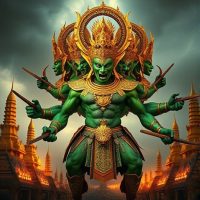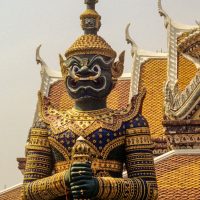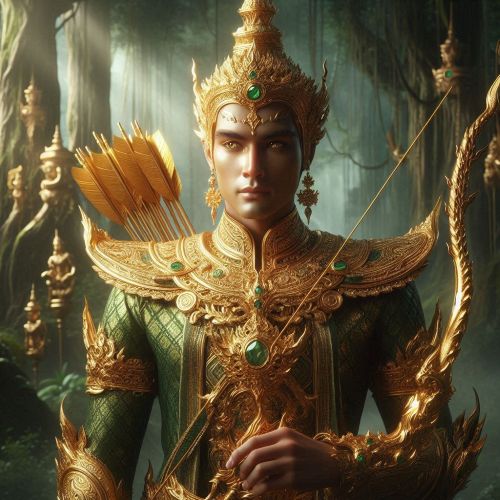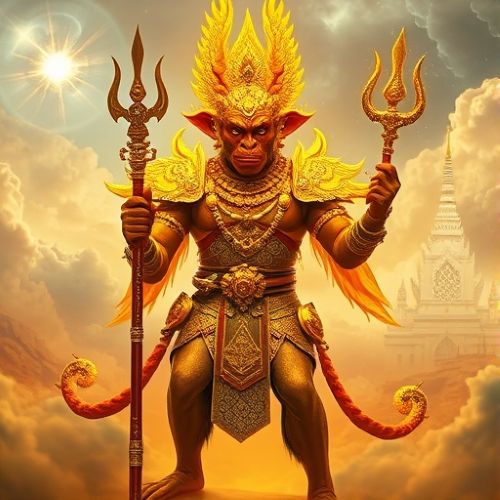Thotsakan : The Demon King
Listen
At a glance
| Description | |
|---|---|
| Origin | Thai Mythology |
| Classification | Demigods |
| Family Members | Phaya Khod (Father), Nang Kala (Mother), Nang Montho (Wife), |
| Region | Thailand |
| Associated With | Royalty, Wisdom |
Thotsakan
Introduction
Thotsakan (ทศกัณฐ์), the mighty demon king of Lanka, stands as one of the most powerful and enduring figures in Thai mythology. Central to the Ramakien, Thailand’s adaptation of the Indian Ramayana, Thotsakan is both antagonist and tragic hero—a being of immense strength, wisdom, and pride whose story explores the boundaries between divinity and downfall. Though rooted in Hindu cosmology as Ravana, the Thai version of Thotsakan has evolved into a unique symbol of cultural identity, embodying royal grandeur, cosmic balance, and the eternal struggle between righteousness (dharma) and desire. His tale continues to shape Thai arts, literature, and moral philosophy, reflecting the timeless resonance of his complex character.
Physical Traits
Thotsakan’s appearance is one of the most iconic in Thai mythology, instantly recognizable in art and performance. He is traditionally depicted with ten heads and twenty arms—each head representing vast intellect, strategic wisdom, and mastery over multiple disciplines. His arms, often wielding celestial weapons, emphasize his unmatched might in both warfare and magic. In classical Thai art, Thotsakan’s skin is usually green, a color symbolizing his supernatural nature and connection to the demonic yet divine realms.
His royal regalia glimmers with gold, featuring ornate jewelry, layered armor, and a towering crown adorned with intricate motifs of Thai craftsmanship. The ten heads are often arranged in tiers, symbolizing not just physical power but also intellectual depth—his ability to command knowledge from various planes of existence. In Khon, Thailand’s traditional masked dance-drama, Thotsakan’s mask is one of the most elaborate, with fierce expressions, wide eyes, and curling fangs, all reflecting his regal authority and inner turmoil. These depictions, seen across temple murals and royal performances, solidify Thotsakan’s visual legacy as both awe-inspiring and intimidating.
Family
Thotsakan’s lineage is as intricate as his character. He descends from a powerful sage named Phaya Khod (the Thai equivalent of Vishrava) and the giantess Nang Kala, giving him both divine wisdom and demonic might. His heritage unites celestial knowledge with infernal strength, symbolizing his internal conflict between virtue and vice.
Among his siblings, Kumbhakan (Kumbhakarna) is notable for his unwavering loyalty and sense of honor, often portrayed as more virtuous than Thotsakan himself. Another brother, Phiphek (Vibhishana), possesses prophetic insight and ultimately sides with Phra Ram (Rama), illustrating the moral divergence within their family. Thotsakan’s beloved consort, Nang Montho (Mandodari), represents grace and loyalty, while his son, Intharachit (Indrajit), is famed for his magical prowess and valor on the battlefield.
The familial dynamics within Thotsakan’s lineage highlight the deeper moral fabric of the Ramakien: loyalty, love, and the tragic consequences of pride. Despite his demonic heritage, Thotsakan’s devotion to his family—particularly his love for Montho and his pride in Intharachit—adds emotional depth to his otherwise fearsome persona.
Other names
Across different cultures and texts, Thotsakan is known by several names, each emphasizing distinct aspects of his character. His most direct counterpart is Ravana, the ten-headed demon king from the Indian Ramayana. The name Thotsakan itself derives from the Sanskrit term Dashakantha, meaning “ten-necked,” referring to his ten heads symbolizing immense knowledge and multi-dimensional thought.
In various regional versions of the Ramakien, he is sometimes referred to as Tosakanth, Thosganth, or King of Longka, the latter referencing his rule over the island kingdom of Lanka (Longka in Thai). These titles reflect how the myth of Thotsakan transcends linguistic and cultural boundaries—each adaptation reshaping him into a symbol of power, intellect, and tragic excess within Southeast Asian mythology.
Powers and Abilities
Thotsakan’s power extends far beyond physical strength. Through intense penance and devotion to the god Shiva, he gained near-immortality and command over powerful celestial weapons. His blessings rendered him invincible to gods, demons, and spirits—though not to mortals, a loophole that would later lead to his downfall.
His ten heads symbolize vast intellect and mastery of multiple sciences and scriptures, while his twenty arms allow him to wield countless divine weapons simultaneously. Thotsakan possesses the ability to shape-shift, fly, and summon vast armies of Rakshasas (demons). His magical skills include illusion, teleportation, and the ability to manipulate cosmic energy. As a sorcerer-king, he combines brute force with profound wisdom, often outsmarting his adversaries in battle.
Yet, despite his formidable might, Thotsakan’s fatal flaw is pride. His abduction of Nang Sida (Sita), the wife of Phra Ram, stems from both desire and arrogance, leading to an epic confrontation that defines the Ramakien. His death at the hands of Phra Ram is not just a defeat in war but a spiritual reckoning—a return to humility and order after the chaos wrought by excessive power.
Modern Day Influence
Thotsakan’s influence in Thai culture endures vividly, blending traditional reverence with modern reinterpretation. In classical Khon performances, Thotsakan’s role remains central, portrayed with dramatic choreography, elaborate masks, and royal music. Each performance captures the emotional depth of his character—his ferocity, his love, and his tragic destiny.
In temple art, particularly at Wat Phra Kaew (Temple of the Emerald Buddha) in Bangkok, grand murals depict Thotsakan’s battles against Phra Ram and Hanuman with striking color and detail. Statues of Thotsakan often stand guard at temple gates, serving as protectors against evil forces, symbolizing strength and vigilance.
Beyond traditional art, Thotsakan has found new life in modern media. He appears in animations, comic books, fashion, and even advertising, often reimagined as a powerful anti-hero or a symbol of Thai identity. His green face and multi-headed form have inspired everything from tourism campaigns to contemporary street art, reflecting his transition from myth to cultural icon.
In education, the Ramakien and the story of Thotsakan continue to be taught as moral parables, emphasizing themes of pride, loyalty, and the balance between power and righteousness. Thotsakan’s tragic grandeur serves as a timeless reminder that wisdom and might, when untempered by humility, can lead even the greatest of kings to ruin.
Ultimately, Thotsakan is more than a mythological villain—he embodies the duality of human nature: the brilliance of intellect and the peril of ego. His legend endures as one of Thailand’s most profound expressions of moral and artistic heritage, bridging ancient mythology with contemporary imagination.
Related Images
Source
Allen, P. J., & Saunders, C. (2019). Thotsakan – The Thai Demon of War. Godchecker. Retrieved November 5, 2025, from https://www.godchecker.com/thai-mythology/THOTSAKAN/
Editorial Team. (2004). Ramakien. Wikipedia. Retrieved November 5, 2025, from https://en.wikipedia.org/wiki/Ramakien
Singaravelu, G. (1982). The Rama Story in the Thai Cultural Tradition. Journal of the Siam Society. Retrieved November 5, 2025, from https://thesiamsociety.org/wp-content/uploads/1982/03/JSS_070_0g_Singaravelu_RamaStoryInThaiCulturalTradition.pdf
Sak Yant & History Of Ramakien. (2024). BKK Tattoo Studio 13. Retrieved November 5, 2025, from https://www.bkktattoostudio13.com/sak-yant-history-of-ramakien.html
Poets.org. (2025). Introduction to extracts from “Ramakien”. Retrieved November 5, 2025, from https://poets.org/text/introduction-extracts-ramakien
Wisdom Library. (2025). Thotsakan. Retrieved November 5, 2025, from https://www.wisdomlib.org/definition/thotsakan
Rajendran, A. (2024, October). Ravana in Ramayana in Thailand – Ravana in Thai Ramakien. Hindu Blog. https://www.hindu-blog.com/2024/10/ravana-in-ramayana-in-thailand-ravana.html
Bunnag, T. (2000). The Ramakien: Thailand’s National Epic. Bangkok: River Books.
Wyatt, D. K. (2003). Thailand: A Short History. Yale University Press.
Brandon, J. R. (1967). Theatre in Southeast Asia. Harvard University Press.
Piriya Krairiksh. (2012). Art and Architecture in Thailand. Silkworm Books.
UNESCO. (2018). Khon Masked Dance Drama. Retrieved from https://ich.unesco.org/en/RL/khon-masked-dance-drama-01385
Frequently Asked Questions
What is lorem Ipsum?
I am text block. Click edit button to change this text. Lorem ipsum dolor sit amet, consectetur adipiscing elit. Ut elit tellus, luctus nec ullamcorper mattis, pulvinar dapibus leo.
What is lorem Ipsum?
I am text block. Click edit button to change this text. Lorem ipsum dolor sit amet, consectetur adipiscing elit. Ut elit tellus, luctus nec ullamcorper mattis, pulvinar dapibus leo.
What is lorem Ipsum?
I am text block. Click edit button to change this text. Lorem ipsum dolor sit amet, consectetur adipiscing elit. Ut elit tellus, luctus nec ullamcorper mattis, pulvinar dapibus leo.
What is lorem Ipsum?
I am text block. Click edit button to change this text. Lorem ipsum dolor sit amet, consectetur adipiscing elit. Ut elit tellus, luctus nec ullamcorper mattis, pulvinar dapibus leo.
What is lorem Ipsum?
I am text block. Click edit button to change this text. Lorem ipsum dolor sit amet, consectetur adipiscing elit. Ut elit tellus, luctus nec ullamcorper mattis, pulvinar dapibus leo.











